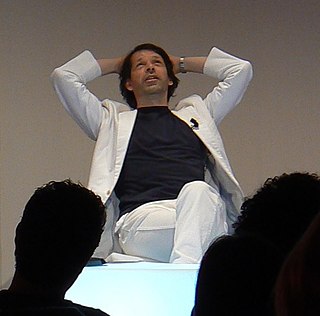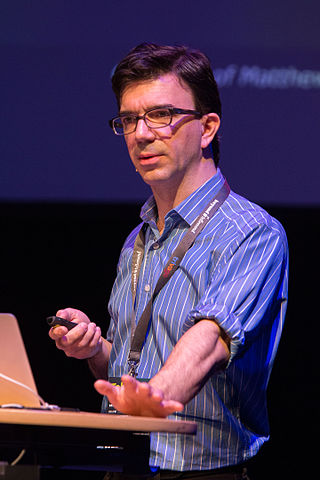
Helvetica, also known by its original name Neue Haas Grotesk, is a widely used sans-serif typeface developed in 1957 by Swiss typeface designer Max Miedinger and Eduard Hoffmann.

Urbanized is a documentary film directed by Gary Hustwit and released on 26 October 2011. It is considered the third of a three-part series on design known as the Design Trilogy; the first being Helvetica, about the typeface, and the second being Objectified, about industrial design. The documentary discusses how cities are designed, and it features interviews with urban planners and architects, such as Oscar Niemeyer and Jan Gehl.

Peter Andrew Saville is an English art director and graphic designer. He designed many record sleeves for Factory Records, which he co-founded in 1978 alongside Tony Wilson and Alan Erasmus.

Tobias Frere-Jones is an American type designer who works in New York City. He operates the company Frere-Jones Type and teaches typeface design at the Yale School of Art MFA program.

Dieter Rams is a German industrial designer who is most closely associated with the consumer products company Braun, the furniture company Vitsœ, and the functionalist school of industrial design. His unobtrusive approach and belief in "less, but better" design has influenced the practice of design, as well as 20th century aesthetics and culture. He is quoted as stating that "Indifference towards people and the reality in which they live is actually the one and only cardinal sin in design."
Mahogany are an electric music-based multidisciplinary media ensemble formed in Michigan in 1995 and currently working in Philadelphia, New York City, Chicago, and other locations. The band's sound combines vocals, cello, massed guitars, pianos, melodicas, sequencers, synthesizers, samplers, tape, percussion, and other instruments. Mahogany also use film, video, animation, cinema, graphic design, photography, typography and other realization and rendering techniques for a cumulative effect that the band refers to as the "Hypercube".

Massimo Vignelli was an Italian designer who worked in a number of areas including packaging, houseware, furniture, public signage, and showroom design. He was the co-founder of Vignelli Associates, with his wife, Lella. His motto was, "If you can design one thing, you can design everything," which the broad range of his work reflects.
Plexifilm was an independent DVD label and film production company co-founded by Gary Hustwit and Sean Anderson in 2001. Plexifilm produced original films, released films theatrically, and produced, distributed and marketed DVDs.

The International Typographic Style is a systemic approach to graphic design that emerged during the 1930s – 1950s but continued to develop internationally. It is considered the basis of the Swiss style. It expanded on and formalized the modernist typographic innovations of the 1920s that emerged in part out of art movements such as Constructivism (Russia), De Stijl and at the Bauhaus (Germany). The International Typographic Style has had profound influence on graphic design as a part of the modernist movement, impacting many design-related fields including architecture and art. It emphasizes simplicity, clarity, readability, and objectivity. Hallmarks of the style are asymmetric layouts, use of a grid, sans-serif typefaces like Akzidenz Grotesk and Helvetica, and flush left, ragged right text. The style is also associated with a preference for photography in place of illustrations or drawings. Many of the early International Typographic Style works featured typography as a primary design element in addition to its use in text, and it is for this that the style is named. The influences of this graphic movement can still be seen in design strategy and theory to this day.
Max Miedinger was a Swiss typeface designer, best known for creating the Neue Haas Grotesk typeface in 1957, renamed Helvetica in 1960. Marketed as a symbol of cutting-edge Swiss technology, Helvetica achieved immediate global success.
Rick Poynor is an English writer on design, graphic design, typography, and visual culture.
Stephen Banham is an Australian typographer, type designer, writer, lecturer and founder of Letterbox, a typographic studio.

Helvetica is a 2007 American independent feature-length documentary film about typography and graphic design, centered on the Helvetica typeface. Directed by Gary Hustwit, it was released in 2007 to coincide with the 50th anniversary of the typeface's introduction in 1957 and is considered the first of the Design Trilogy by the director.

Objectified is a feature-length documentary film examining the role of everyday non-living objects and the people who design them, in our daily lives. The film is directed by Gary Hustwit. Objectified premiered at the South By Southwest Festival on March 14, 2009.
Norm, is an experimental graphic design team best known for their typography. Their most influential project is typography for Cologne Airport. It is co-founded by two Swiss designers Dimitri Bruni and Manuel Krebs and later joined by Ludovic Varone. Their approach to typography is known to be very strict and rigorous with strong modernist features but with slight references to postmodernism.
Mike Russell Parker was a British-born American typographer and type designer.
The Design Trilogy is the collective name of a series of three documentary films about design directed by film director Gary Hustwit.

Mark Simonson is an American independent type designer who works in St. Paul, Minnesota.

Rams is a documentary film about German industrial designer Dieter Rams, directed by Gary Hustwit.
Jon Pack is an American photographer based in New York City. Pack is known as a photojournalist and street photographer, and for his work as an on-location still photographer for film and television productions.










